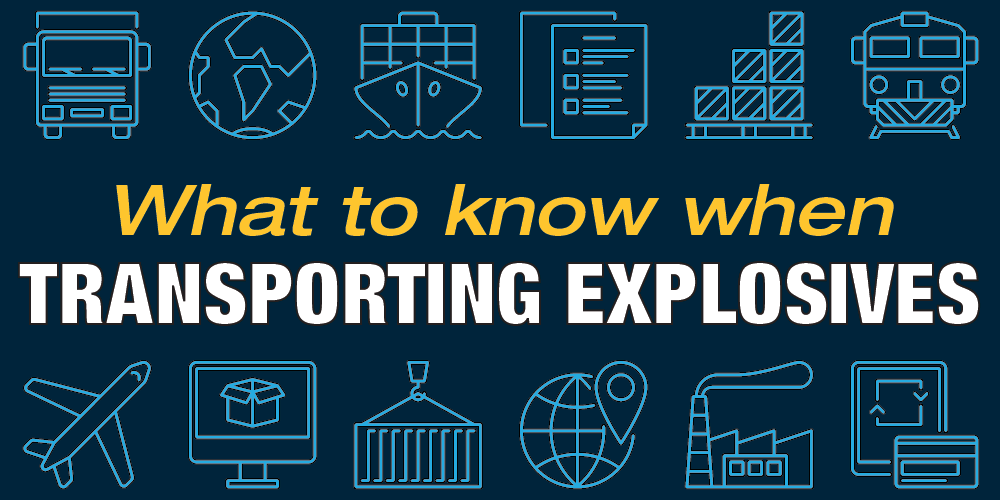If your business is like most, you don’t usually deal with shipping explosives in Class 1. However, this class sometimes shows up in places you’d least expect it. While it’s expected to deal with explosives in construction, mining, and the military, you can also find explosives in unexpected products such as toys (caps for cap guns), pyrotechnics for stage and movie productions, and animal tracking collars (some use explosive bolts to free the animal so it doesn’t have to make a permanent fashion statement).
Shipping explosives can be more complex than many other classes of dangerous goods. They are subject to other regulations, such as the Explosives Act, and may require special licensing depending on what type they are. In addition, they are often excluded from some of the common exemptions found in Canada’s Transportation of Dangerous Goods Regulations (TDGR). For example, explosives can’t use the Limited Quantity exemption of section 1.17, or the Excepted Quantity exception found in section 1.17.1. Some low-level explosives may qualify for the 150 Kilogram Gross Mass Exemption in section 1.15 and the 500 Kilogram Gross Mass Exemption in section 1.16, but only if they fall into certain divisions, compatibility groups or UN numbers. You’ll need to read each exemption closely to ensure that your particular explosive will qualify.
To balance things out, TDGR does contain some provisions for shipping small amounts of low-level explosives more easily. However, these provisions may seem confusing for those who are used to the relatively straight-forward limited quantity rules.
The main exemption found in Part 1 of TDG is section 1.31. This is called, helpfully, the Class 1, Explosives Exemption. Some refer to it as “limited quantity for explosives,” since it shares some of the features found in limited quantities. But be careful using it, because many other parts of its provisions are quite different from limited quantities for other classes.
First, using section 1.31 will exempt you from Part 3 (Documentation), Part 4 (Dangerous Goods Safety Marks), Part 6 (Training), Part 9 (Road) and Part 10 (Rail). You won’t need to comply with these parts for the handling, offering for transport or transporting of your explosive by road or rail. Note that this exemption doesn’t apply to shipment by air or water (even domestically).
To determine if an explosive qualifies, first go to Schedule 1, and look up the explosive by UN number. Let’s say you’re shipping shotgun shells. These will be classified as UN0012, CARTRIDGES, SMALL ARMS. Check Column 6a, “Explosive Limit and Limited Quantity Index.” For Class 1 material this will not be a limited quantity index – instead, it will be the Net Explosives Quantity (NEQ) that can be shipped as exempted under section 1.31. In this example, for UN0012, the number is 25, indicating a maximum NEQ of 25 kilograms.
Note that “net explosives quantity” is not the net weight as it would be calculated for non-explosive substances. NEQ is defined in section 1.4 as “the net mass of explosives, excluding the mass of any means of containment.” Explanatory text clarifies that “[s]ome explosives are articles and depend on the means of containment to achieve an explosive effect. This definition clarifies that, even in such a case, only the mass of explosives is counted.” So, when calculating the NEQ of your shotgun shells, base it on the net amount of explosive substance (gunpowder in this case), but not including the packaging, casings or pellets. The NEQ will be significantly lower than the net weight of the shells as a whole. But remember, it’s the gunpowder that poses the danger, not the rest of the article.
Next, add up the amount of gunpowder in the shipment you’re sending. Let’s say, for ease of calculation, each shell contains one gram of gunpowder and each package contains 200 shells. The NEQ for one box would be 200 g. If you’re shipping ten boxes, the NEQ of the shipment would be 2 kilograms.
This is good news, because according to Schedule 1 for UN0012, shipments with a NEQ not exceeding 25 kilograms do not require normal TDG shipping documents or safety marks. Also, shippers, carriers and receivers don’t have to be TDG-trained. However, there are still some things you’ll have to do to comply with this exemption:
- Each package must be certified as UN specification, if required by TDGR Part 5 and the related standard CGSB 43.151, “Packaging, handling, offering for transport and transport of Explosives (Class 1)”.
- Each outer package must be marked with the class, compatibility group and UN number of the explosives contained inside. In this example, you would mark each package with “Class 1.4S, UN0012”. Note that no shipping name or Class 1 label will be required.
Although the exemption says you do not have to comply with TDGR Part 4, Safety Marks, subsection 1.31(d) requires you to placard the vehicle as required for the division of the explosive. This applies if you’re shipping more than 10 kilograms NEQ and the explosives are in any of the divisions 1.1, 1.2, 1.3 or 1.5. Note that if Special Provisions 85 or 86 apply to the UN number, instead of using the NEQ, placarding is based on the number of articles – you must provide placards if the number of articles in the shipment exceeds 1,000. Fortunately, in this example the ammunition is in Division 1.4, and will not require placards as long as we stay within the weight limit of the exemption.
Section 1.31 provides some basic relief for shippers of low-powered explosives in small quantities. Unfortunately, unlike the limited quantity option for non-explosives found in section 1.17, the exemption is based on the size of the shipment. So what happens if you need to ship more packages, and now the load has an NEQ of, say, 30 kilograms? You can no longer use section 1.31. You’d have to repackage the whole shipment in UN packaging, label and mark each package fully, and provide a shipping document. Isn’t there an easier solution?
The answer depends on the shipping description, but in some cases, such as for UN0012, there is another route that is more closely aligned with the genuine “limited quantity” provisions. Some UN numbers, including UN0012, will be assigned Special Provision 125 by Schedule 1, which will allow you to ship an unlimited amount of product per vehicle if you comply with the following:
- Your explosives are classified and authorized in accordance with the “Explosive Regulations, 2013″;
- They are contained in inner means of containment that are placed in a strong outer means of containment designed, constructed, filled, closed, secured and maintained so that under normal conditions of transport, including handling, there will be no accidental release of the dangerous goods that could endanger public safety (but does not have to be UN specification);
- Each inner means of containment has a gross mass less than or equal to 5 kilograms;
- Each outer means of containment (that is, the package as assembled) has a gross mass less than or equal to 30 kilograms;
- Each package is marked as a limited quantity using the diamond marking shown in subsection 1.17(5), and
- Each package, as presented for transport, is capable of passing a test in accordance with Test Series 6(d) of Part I of the Manual of Tests and Criteria. (That is, the explosive package has been tested as per the protocols in the UN Recommendations on the Transport of Dangerous Goods. Most commercial explosives will have been tested for this, or at least can be deemed capable of passing these tests.)
The authorized mark for explosives going under this provision is the limited quantity diamond. Note that you aren’t authorized to use the other marks in section 1.17, such as the words “limited quantity” or “consumer commodity,” which are due to be phased out by 2021.
If you comply with Special Provision 125, you can otherwise treat the shipment as you would limited quantities of non-explosives for TDGR purposes. That means you don’t need dangerous goods shipping papers, no other marks or labels on the package, or placards for any size shipment, and handlers and carriers don’t have to be TDGR-certified. Much easier!
Do you have any questions about this or other exemptions in the TDG Regulations? Contact ICC Compliance Center here at 888-442-9628 (U.S.) or 888-977-4834 (Canada), and ask for one of our regulatory specialists. We can help you complete the process safely and efficiently.






